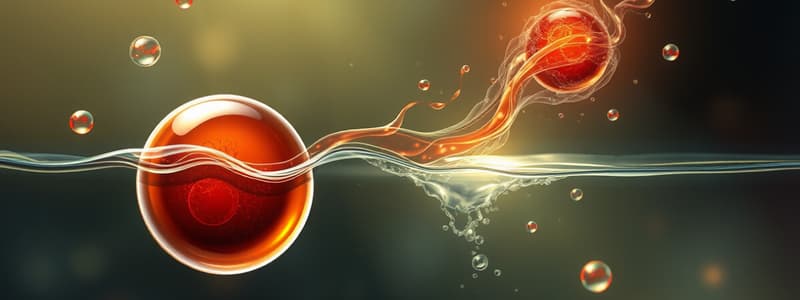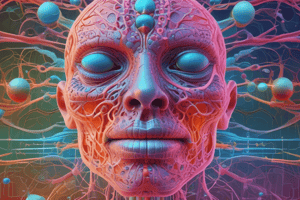Podcast
Questions and Answers
Which variable is NOT a part of homeostasis?
Which variable is NOT a part of homeostasis?
- Blood pressure
- Blood glucose levels
- Weight of an individual (correct)
- Core temperature
The control centre is responsible for detecting changes in homeostatic parameters.
The control centre is responsible for detecting changes in homeostatic parameters.
False (B)
What are the two types of body fluids mentioned?
What are the two types of body fluids mentioned?
Intracellular and extracellular
The normal range for core temperature is _____ to _____ °C.
The normal range for core temperature is _____ to _____ °C.
Match the components of the homeostatic control system with their functions:
Match the components of the homeostatic control system with their functions:
Which of the following is an example of extracellular fluid?
Which of the following is an example of extracellular fluid?
Homeostasis is a static process that does not change over time.
Homeostasis is a static process that does not change over time.
What role do effectors play in homeostatic control?
What role do effectors play in homeostatic control?
Which of the following best describes homeostasis?
Which of the following best describes homeostasis?
Metabolism is exclusively related to the physical growth of an organism.
Metabolism is exclusively related to the physical growth of an organism.
What is the primary function of cell division?
What is the primary function of cell division?
The two types of cell division are _____ and _____
The two types of cell division are _____ and _____
Match the following concepts with their descriptions:
Match the following concepts with their descriptions:
Which statement about cell organelles is correct?
Which statement about cell organelles is correct?
The loss of heartbeat is one of the characteristics of life.
The loss of heartbeat is one of the characteristics of life.
What are the three main components of a feedback mechanism?
What are the three main components of a feedback mechanism?
Which feedback system tends to strengthen or reinforce change in a controlled condition?
Which feedback system tends to strengthen or reinforce change in a controlled condition?
Negative feedback works to amplify the response to a stimulus in the body.
Negative feedback works to amplify the response to a stimulus in the body.
What is the main muscle involved in separating the thoracic cavity from the abdominal cavity?
What is the main muscle involved in separating the thoracic cavity from the abdominal cavity?
A negative feedback system works to maintain or restore __________.
A negative feedback system works to maintain or restore __________.
Match the following body systems with their primary functions:
Match the following body systems with their primary functions:
Which of the following is NOT an example of negative feedback?
Which of the following is NOT an example of negative feedback?
The organism is the smallest unit in the hierarchy of biological organization.
The organism is the smallest unit in the hierarchy of biological organization.
What does the term 'Vital Force' refer to?
What does the term 'Vital Force' refer to?
Flashcards are hidden until you start studying
Study Notes
Homeostasis and Its Importance
- Homeostasis refers to the dynamic state of balance within the body, crucial for maintaining life processes.
- Physiological variables that must remain in balance include core temperature (36.5-37.5°C), water and electrolyte concentrations, blood glucose levels, and acid-base balance (pH).
- Blood and tissue O2/CO2 levels and blood pressure are also critical parameters for homeostasis.
Body Fluids
- Body fluids are categorized into intracellular and extracellular types, including blood plasma, synovial fluid, lymph fluid, and interstitial fluid.
- The proper function of body cells relies on the composition and volume of interstitial fluid, which alters as substances exchange with blood.
Homeostatic Control Systems
- Homeostasis is subject to disruption, requiring control systems for stabilization:
- Disruptors: Factors that change homeostatic parameters.
- Detectors: Receptor systems, often nerves, that identify disruptions.
- Control Centers: Establish appropriate limits for each variable, processing input to produce output.
- Effectors: Structures that respond to outputs from the control center.
Feedback Mechanisms
- Feedback systems involve receptors, effectors, and control centers that communicate changes:
- Negative Feedback: Reverses changes to maintain balance; examples include regulating body temperature, blood glucose, and blood pressure.
- Positive Feedback: Reinforces changes under specific conditions, such as childbirth, milk production, and blood clotting.
Body Organization
- The body is structured in levels:
- Atoms and molecules constitute the chemical level.
- Cells are the smallest living units.
- Tissues are composed of groups of cells with similar functions.
- Organs consist of multiple tissue types working together.
- Systems are related organs functioning collectively.
- The organism encompasses all body parts.
Human Body Systems
- Major systems include the skeletal, muscular, respiratory, cardiovascular, digestive, endocrine, lymphatic, integumentary, urinary, reproductive, nervous, and immune systems.
- Vital Force or Life Force influences the functioning of all body systems.
Body Cavities
- Four primary cavities house the body's organs:
- Cranial
- Thoracic
- Abdominal
- Pelvic
- The diaphragm separates the thoracic cavity from the abdominal cavity, also serving as a primary muscle for breathing.
Fundamental Concepts in Biomedicine
- Anatomy: Study of body structures.
- Physiology: Function of body parts.
- Pathology: Abnormalities in normal functions.
- Key terms include metabolism (chemical processes), responsiveness to change, movement, reproduction, growth, differentiation, and the concept of the Vital Force or Qi.
Characteristics of Life and Death
- Characteristics of life encompass metabolism, responsiveness, movement, reproduction, growth, and differentiation.
- Death is characterized by the loss of heartbeat, absence of breathing, loss of brain function, and cessation of the Vital Force.
Studying That Suits You
Use AI to generate personalized quizzes and flashcards to suit your learning preferences.




